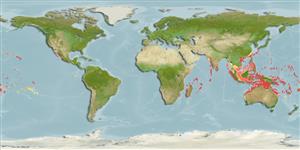Environment: milieu / climate zone / depth range / distribution range
Ökologie
seewasser riff-verbunden; tiefenbereich 1 - 50 m (Ref. 9710), usually 1 - 50 m (Ref. 27115). Tropical; 24°C - 28°C (Ref. 27115); 30°N - 30°S, 30°E - 89°W
Indo-pan-Pacific: East Africa to the Galapagos Is. north to southern Japan, south to the southern Great Barrier Reef and New Caledonia, Tuamotus, throughout Micronesia
Size / Gewicht / Alter
Maturity: Lm ? range ? - ? cm
Max length : 60.0 cm TL Männchen/unbestimmt; (Ref. 3145)
Rückenflossenstacheln (insgesamt): 6; Rückenflossenweichstrahlen (insgesamt): 26-27; Afterflossenstacheln 3; Afterflossenweichstrahlen: 27 - 29. Adults develop a convexly rounded prominent snout and unusually tall dorsal and anal fins. Side of body with vertical blue lines which break up into small blue spots dorsally and ventrally. A broad blue band extending from eye to front of rostral protuberance (Ref 9808).
Occurs in deep lagoon and seaward reefs. Found forming loose schools along upper regions of deep drop-offs (Ref. 48637). Forms mid-water aggregations off steep slopes during the day to feed on zooplankton. Usually found alone or in pairs. Omnivorous. Has the ability to show or hide its blue markings (Ref. 9710). Minimum depth reported taken from Ref. 27115.
Life cycle and mating behavior
Geschlechtsreife | Fortpflanzung | Ablaichen | Eier | Fecundity | Larven
Myers, R.F., 1991. Micronesian reef fishes. Second Ed. Coral Graphics, Barrigada, Guam. 298 p. (Ref. 1602)
IUCN Rote Liste Status (Ref. 130435)
Bedrohung für Menschen
Harmless
Nutzung durch Menschen
Warning: mysqli::__construct(): (HY000/1040): Too many connections in /var/www/html/includes/func_getlabel.php on line 46
Can't connect to MySQL database (fbapp). Errorcode: Too many connections
